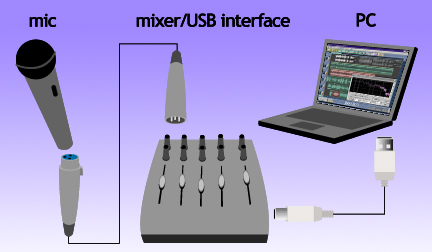| Software Music Machine Archive |
|
The Cool Edit Studio-a-go-go! Multi-track recording tips
Want to start recording music, but don't know where to start? This three-part guide will have you making music in no time.
Real-world applications for audio production
The Cool Edit Studio-a-go-go!
by David Miles Huber
In the not-too distant past, recording your own music meant hiring out a professional recording studio to record and mix your own music. Nowadays, with the dawning of the project studio, laying down your tracks at home, on the road or in your project studio is a basic fact of the music biz. Still, with all the tools and technology that at our disposal, the concept of laying down your own tracks for the purpose of making a pro-sounding demo or creating a finished project can be an expensive, complex and technically-frustrating task.
One of the most basic of tools for the aspiring musician, songwriter and producer is the portable studio. (I can't really use the word "Portastudio(r)", cause it's a Tascam trademark, Well, I could, but that wouldn't be right...). These hardware devices originally started out as cassette-based recorders that offered four tracks and housed a simple mixer/transport user interface. More recently, these boxes have begun to appear as hard disk and minidisk-based devices that can store mix and process audio in the digital domain. At last, this means that the audio quality is finally acceptable enough to record, overdub, bounce and mix audio with truly pro-sounding results.
Although these "studios in a box" are simple in nature and can be taken virtually anywhere, the main drawback to the portable studio is that it's basically limited in nature, usually offering:
- Only four or eight tracks (which usually means that extensive track copying (bouncing) is needed when additional tracks are required.
- Limited or no internal effects capabilities.
- Limited mixing features w/o automation.
- Limited or no editing features.
Cool Edit Studio-on-the-go
CE 2000 and Cool Edit Pro both combine the ease and straightforwardness of a portable-studio, with the power and flexibility of a digital audio editor... allowing even the most technically-challenged to record, overdub and mix finished tracks... all without the big bucks, complex gear and the technical frustrations that can often plague even the most modern of project studios.
Seriously, folks... CE2K and CEP is not only cheaper that a hardware porta-system (much cheaper than the newer, hard disk systems)... it's FAR more powerful. For example, the Cool Edit family of editors:
- Are easier to use than most dedicated porta-systems.
- Offer more tracks (up to 64)!
- Include an impressive number of great-sounding DSP effects.
- Offer on-screen editing, grouping and track layout options.
- Offer advanced mixing and output-routing options.
- Let you mixdown your music to a stereo wavefile that can be instantly burned to CD!
Literally, CE 2000 and Cool Edit Pro act as straightforward yet powerful production systems that let you translate your musical ideas directly to hard disk, without the need of complex outboard gear and expensive recording hardware. All you need is a computer and a high-quality soundcard interface. Using a mic to record a live source means that you'll probably need a mixer (like the Mackie 1202), a mic preamp or an interface that has a built-in mic preamp (like the Tascam US-428). Getting your sound onto hard disk, mixing it and even burning the finished tracks to CD couldn't be easier...

Record it! You can record tracks into Cool Edit Pro in either mono or stereo (or if you use a soundcard that has multiple inputs, you can record several tracks into a session simultaneously. Once recorded, the track(s) can be mixed, panned, processed and saved as a session file (Any number of session mix versions can be saved to disk for later recall.) Overdub it! Wanna add an instrumental or vocal track to the existing mix at a later time? No problem; simply assign an audio input to a new track, arm the record button, place the curser at the point where you wish to begin and get down to the biz of making music! Mix it!Once you've finished recording your tracks, you can go about the task of setting the final levels, pan positions and effects (using any of the 40+ out-of-the-box DSP or 3rd party DirectX effects). Burn it! Now that you have the perfect mix, simply mixdown the session (along with any other songs in the project that you might have finished) to a wave file... import the songs into your favorite CD burning software program and voila... you'll have a finished CD project in your hot little hands for all the world to hear!
Share This Article |